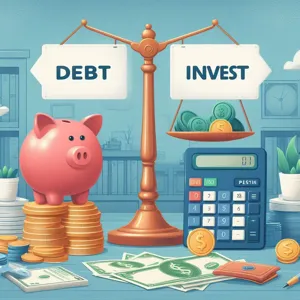When it comes to building financial security and growing your wealth, deciding between paying off debt and investing can be a challenging dilemma.
On one hand, eliminating debt reduces financial burdens and interest costs, offering peace of mind and a stronger cash flow. On the other, investing opens the door to potential growth and long-term wealth accumulation through the power of compounding returns. But which strategy truly accelerates your journey to financial freedom? In this blog post, we’ll dive deep into the pros and cons of paying off debt versus investing, helping you understand how to make informed decisions that align with your personal goals and financial situation. Whether you’re just starting out or looking to optimize your money management, this guide will provide valuable insights to help you build wealth faster and smarter.
1. Understanding Debt and Its Impact on Wealth

Before diving into the age-old debate of paying off debt versus investing, it’s crucial to understand what debt really means and how it affects your overall financial health. Debt comes in many forms—credit card balances, student loans, mortgages, car loans, and personal loans—and each type carries its own interest rates and terms. While some debt, like a mortgage or a student loan, can be considered “good debt” because it may help build your future, high-interest debt, especially credit card debt, can quickly become a heavy burden that eats away at your wealth.
When you carry debt, a portion of your income goes toward interest payments rather than being available for saving or investing. This reduces your ability to grow your net worth over time. High-interest debt, in particular, can compound against you rapidly, making it harder to escape its grip and slowing down your progress toward financial freedom.
Moreover, debt can limit your financial flexibility. It may restrict your ability to seize investment opportunities or handle unexpected expenses, potentially forcing you to take on even more debt. Understanding these impacts is the first step in crafting a strategy that balances debt repayment and investing in a way that accelerates your wealth-building journey.
2. The Basics of Investing for Wealth Building
Investing is a powerful tool for building long-term wealth, but understanding the basics is crucial before diving in. At its core, investing involves putting your money into assets—such as stocks, bonds, mutual funds, or real estate—with the expectation that these assets will grow in value over time. Unlike simply saving money in a bank account, which typically offers minimal interest, investing allows your money to work for you by potentially generating higher returns through capital appreciation, dividends, or interest.
One of the key principles of investing is the concept of compounding. This means that the returns you earn on your investments are reinvested, allowing you to earn returns on your returns. Over time, compounding can significantly accelerate wealth growth, especially when you start investing early and remain consistent.
It’s also important to understand risk and diversification. All investments carry some level of risk—the chance that you might lose money. However, spreading your investments across different asset classes and sectors can help reduce this risk. By diversifying, you protect your portfolio from the volatility of any single investment.
Before you start investing, consider your financial goals, time horizon, and risk tolerance. Whether you’re investing for retirement, buying a home, or simply building an emergency fund, having a clear plan will guide your decisions. Remember, investing is a marathon, not a sprint—patience and discipline are key to seeing your wealth grow.
In the context of paying off debt versus investing, understanding these investing basics helps you weigh which path can potentially build your wealth faster, depending on your individual financial situation.
3. Comparing Interest Rates: Debt vs. Investment Returns

When deciding whether to pay off debt or invest, one of the most crucial factors to consider is the comparison between the interest rates on your debt and the potential returns from your investments. High-interest debt, such as credit card balances or payday loans, often carries rates upwards of 15% to 25%, which can quickly compound and erode your financial stability. On the other hand, typical investment returns, whether from stocks, bonds, or mutual funds, tend to average around 7% to 10% annually over the long term.
If your debt interest rate is significantly higher than the expected return on investments, it generally makes more sense to prioritize paying off that debt first. By doing so, you effectively earn a guaranteed return equal to the interest rate you would have otherwise paid. For example, paying off a credit card debt with a 20% interest rate is like earning a risk-free 20% return — an opportunity few investments can match.
Conversely, if you have low-interest debt, such as a mortgage or student loans with rates below the average market returns, investing may be a more attractive option. In this case, the potential gains from investments could outweigh the cost of holding onto the debt, accelerating your wealth-building journey. However, it’s important to consider your risk tolerance and financial goals, as investments carry inherent uncertainties.
Ultimately, carefully analyzing and comparing your debt interest rates with realistic investment returns can help you make informed decisions that align with your personal financial situation, allowing you to build wealth in the most efficient way possible.
4. Types of Debt: Good Debt vs. Bad Debt
Understanding the difference between good debt and bad debt is crucial when deciding whether to focus on paying off debt or investing. Good debt is typically considered an investment in your future that has the potential to increase your net worth or generate income. Examples include mortgages on property that appreciates over time, student loans that enhance your earning potential, or a business loan that helps grow your company. This type of debt often comes with lower interest rates and can be a strategic tool for building wealth.
On the other hand, bad debt usually refers to borrowing that does not add value to your financial situation and often comes with high interest rates. Credit card debt, payday loans, and high-interest personal loans fall into this category. Bad debt can quickly snowball, eating away at your finances and making it harder to save or invest.
When weighing paying off debt versus investing, prioritizing the elimination of bad debt is generally advisable. The high interest on bad debt often outweighs the potential returns from investments. Conversely, carrying good debt while investing can sometimes accelerate wealth-building, especially if your investments yield higher returns than your debt’s interest rate.
By distinguishing between these two types of debt, you can make informed decisions that align with your financial goals and optimize your path to wealth.
5. The Psychological Benefits of Paying Off Debt

Paying off debt offers significant psychological benefits that can positively impact your overall financial well-being and mindset. Carrying debt often leads to stress, anxiety, and a constant feeling of financial burden. By systematically paying down your debts, you not only reduce your financial obligations but also gain a sense of control and accomplishment. This emotional relief can motivate you to maintain better money habits and stay committed to your long-term financial goals.
Moreover, becoming debt-free often brings peace of mind, freeing up mental space that was previously consumed by worries about interest rates, payment deadlines, or potential credit score damage. This clarity can empower you to focus more confidently on investing and wealth-building strategies in the future. In essence, the psychological boost from paying off debt can create a positive feedback loop—reducing stress, increasing motivation, and ultimately accelerating your journey toward financial freedom.
6. The Power of Compound Interest in Investing
One of the most compelling reasons to consider investing as a pathway to building wealth is the power of compound interest. Unlike simple interest, which is calculated only on the original amount you invest, compound interest allows your earnings to generate their own earnings over time. This means that not only are you earning returns on your initial investment, but you’re also earning returns on those returns—creating a snowball effect that can significantly accelerate your wealth growth.
For example, if you invest $5,000 at an annual return of 7%, after the first year, you’ll earn $350 in interest. In the second year, your interest is calculated on $5,350, not just the original $5,000, so your earnings increase. Over decades, this compounding effect can turn modest investments into substantial sums.
It’s important to start investing early to maximize the benefits of compounding. The longer your money stays invested, the more opportunities it has to grow exponentially. While paying off debt is crucial, especially high-interest debt, harnessing compound interest through investing can often build wealth at a faster pace in the long run. Understanding and leveraging this principle can be a game-changer when deciding how to allocate your financial resources wisely.
7. When Paying Off Debt Makes More Financial Sense

Paying off debt can often be the smarter financial move, especially when the interest rates on your debt are higher than the potential returns you might earn through investing. High-interest debts, such as credit card balances or personal loans, can quickly accumulate and become a significant financial burden. By focusing on eliminating these debts first, you effectively earn a guaranteed return equal to the interest rate you’re avoiding. For example, if you have credit card debt with a 20% interest rate, paying it off is like making a risk-free 20% return—something that’s hard to match in the stock market.
Moreover, reducing debt improves your overall financial health by increasing your credit score and freeing up cash flow, which can later be redirected into investments. It also provides peace of mind, reducing financial stress and giving you a stronger foundation to build wealth. In cases where debt interest rates are exceptionally high or when you have variable-rate debt that could increase over time, prioritizing debt repayment can shield you from escalating costs. Ultimately, when your debt is costing you more than what you could realistically earn through investing, paying it off first is a strategic move that accelerates your journey to financial freedom.
8. Situations Where Investing First Is More Advantageous
While paying off debt is often a prudent financial move, there are specific situations where investing first can actually help build wealth more quickly. One key factor to consider is the interest rate on your debt compared to the expected return on your investments. For example, if you have low-interest debt—such as a mortgage with an interest rate below 4%—and you have opportunities to invest in assets with higher average returns, like the stock market historically averaging 7-10% annually, investing might be the smarter choice.
Another scenario is when you have access to employer-sponsored retirement plans, such as a 401(k) with matching contributions. In this case, investing enough to get the full match is essentially “free money” and can significantly boost your wealth over time. Skipping these contributions to pay off debt first could mean missing out on valuable gains.
Additionally, if you have a stable income and an emergency fund in place, investing early allows you to benefit from the power of compound interest. The sooner you start, the more time your investments have to grow, potentially outpacing the cost of your debt.
Ultimately, the decision depends on your unique financial situation, including your debt type, interest rates, investment opportunities, and risk tolerance. Evaluating these factors carefully will help you decide whether investing first makes sense on your path to building wealth.
9. Balancing Debt Repayment and Investment Strategies
Finding the right balance between paying off debt and investing can be a pivotal decision in your journey toward building wealth. On one hand, aggressively paying down high-interest debt, such as credit cards or personal loans, can provide a guaranteed return by saving you from paying exorbitant interest rates. On the other hand, investing your money—especially in accounts or assets with higher potential returns—can grow your wealth over time, thanks to the power of compounding.
The key is to assess your individual financial situation. If you have high-interest debt, prioritizing repayment often makes sense because the interest you pay usually outweighs the returns you might earn from investments. However, if your debts carry low interest rates, such as certain student loans or mortgages, you might benefit from allocating some funds to investments simultaneously.
A balanced approach might involve making minimum payments on debts while gradually increasing your investment contributions. This strategy not only reduces your debt burden but also allows your money to start working for you sooner. Remember, personal finance is not one-size-fits-all — regularly reviewing your goals, risk tolerance, and market conditions will help you adjust your balance between debt repayment and investing to maximize long-term wealth.
10. Real-World Examples and Case Studies
To truly understand whether paying off debt or investing builds wealth faster, let’s look at some real-world examples and case studies that highlight the outcomes of each approach.
**Case Study 1: The Conservative Debt-Payer**
Meet Sarah, who had $20,000 in credit card debt with an interest rate of 18%. She chose to focus on paying off this high-interest debt aggressively before making any investments. Within two years, Sarah was debt-free and then began investing in a diversified portfolio. By avoiding the high interest charges, she saved thousands of dollars that would have otherwise been lost to interest payments. Over the next five years, her investments grew steadily, and because she had zero debt, all her returns contributed directly to building her net worth.
**Case Study 2: The Balanced Investor**
John had $15,000 in student loans at a 5% interest rate and $10,000 saved for investing. Instead of paying off the loans aggressively, he decided to invest half his savings while making minimum payments on his debt. Over a decade, the stock market’s average return outpaced his loan interest, allowing his investments to grow substantially. However, his debt payments did slow his progress slightly, and during market downturns, he felt more financial stress.
**Case Study 3: The Aggressive Investor**
Emily had no debt but $30,000 in savings. She invested all her funds immediately, capitalizing on market growth. Over 15 years, her wealth grew significantly, but she acknowledged that avoiding debt from the start gave her a clear advantage.
These examples illustrate that the best strategy often depends on the type and interest rate of your debt, your risk tolerance, and your financial goals. High-interest debt typically warrants prioritizing repayment, while low-interest debt might allow you to invest simultaneously. Ultimately, combining both strategies thoughtfully—paying down costly debt while investing wisely—can accelerate wealth building and lead to greater financial security.
11. Tax Implications of Debt and Investments
When deciding between paying off debt and investing, it’s crucial to consider the tax implications associated with each option, as they can significantly impact your overall financial growth.
**Tax Benefits of Paying Off Debt:**
Certain types of debt, such as mortgage interest or student loans, may offer tax deductions that reduce your taxable income. For example, mortgage interest deductions can lower your tax burden, effectively making the cost of your debt less expensive. However, once the debt is paid off, you lose these deductions, though you gain the advantage of having no interest payments, freeing up cash flow in the long run.
**Taxation on Investment Returns:**
Investments come with their own set of tax considerations. Depending on the type of investment—stocks, bonds, mutual funds, or retirement accounts—your earnings may be subject to capital gains tax, dividend tax, or income tax. Long-term capital gains (on assets held over a year) are generally taxed at a lower rate than short-term gains, encouraging longer investment horizons. Additionally, tax-advantaged accounts like IRAs or 401(k)s can help defer or reduce taxes, boosting your investment growth over time.
**Weighing the Impact:**
When evaluating whether to allocate extra funds towards debt repayment or investing, factor in how taxes will affect your net returns and savings. For instance, if your debt carries a high interest rate with no tax deduction, prioritizing payoff may provide a guaranteed “return” equivalent to the interest saved. Conversely, if your investments offer tax-advantaged growth that outpaces your debt interest rate, investing might build wealth faster despite the tax obligations.
Understanding these tax nuances can help you craft a strategy that maximizes your financial position. It’s often beneficial to consult with a financial advisor or tax professional to analyze your specific situation and make informed decisions tailored to your goals.
12. Building an Emergency Fund Before Debt or Investment
Before diving into the often-debated choice between paying off debt and investing, it’s crucial to establish a solid financial foundation by building an emergency fund. An emergency fund acts as a financial safety net, providing you with quick access to cash in case of unexpected expenses such as medical emergencies, car repairs, or sudden job loss. Without this cushion, you risk having to rely on high-interest credit cards or loans, which can derail both your debt repayment and investment plans.
Financial experts generally recommend saving three to six months’ worth of living expenses in a readily accessible account, like a high-yield savings account. This fund not only brings peace of mind but also prevents you from having to liquidate investments prematurely or take on additional debt during tough times. By securing your emergency fund first, you create a stable platform that allows you to make more strategic decisions regarding whether to accelerate debt repayment or begin investing, ultimately supporting faster and more sustainable wealth building.
13. Creating a Personalized Financial Plan
Creating a Personalized Financial Plan
When it comes to deciding between paying off debt and investing, there’s no one-size-fits-all answer. That’s why creating a personalized financial plan is essential. A tailored plan takes into account your unique financial situation, goals, risk tolerance, and timeline, allowing you to make informed decisions that align with your long-term wealth-building objectives.
Start by assessing your current financial health: list out your debts, interest rates, monthly income, expenses, and existing investments. Understanding these details helps you identify which debts are costing you the most and where your investment opportunities lie. Next, clarify your financial goals—whether it’s becoming debt-free in a certain timeframe, saving for retirement, buying a home, or building an emergency fund.
With this information, you can prioritize actions effectively. For example, you might decide to aggressively pay down high-interest credit card debt while making consistent contributions to a retirement account. Alternatively, if you have low-interest debt, you may choose to invest more heavily to take advantage of potential market growth.
Remember, your financial plan isn’t static. Life changes, market fluctuations, and evolving goals mean you should revisit and adjust your plan regularly. Consulting with a financial advisor can also provide valuable insights tailored to your circumstances. Ultimately, a personalized financial plan empowers you to strike the right balance between paying off debt and investing, accelerating your journey toward lasting wealth.
14. Common Mistakes to Avoid in Debt and Investment Decisions
When it comes to managing your finances, making smart decisions about debt repayment and investing is crucial. However, many people fall into common traps that can hinder their path to building wealth. One frequent mistake is neglecting to fully understand the terms and interest rates associated with their debts. High-interest debts, like credit cards, can quickly accumulate and outweigh any potential gains from investments, so prioritizing their payoff is often wise. Conversely, some individuals delay investing altogether, missing out on the power of compound growth over time.
Another pitfall is attempting to do both without a clear plan, which can lead to spreading resources too thin and achieving suboptimal results in both areas. Emotional decision-making, such as selling investments during market downturns or taking on unnecessary debt for lifestyle purchases, can also derail long-term financial goals. Lastly, failing to regularly review and adjust your strategy as life circumstances change—whether it’s a new job, a raise, or unexpected expenses—can cause missed opportunities for accelerating wealth growth.
By being aware of these common mistakes and approaching debt repayment and investing with a balanced, informed plan, you can position yourself to build wealth more efficiently and with greater confidence.
15. Final Thoughts: Finding the Right Strategy for You
When it comes to building wealth, there is no one-size-fits-all answer when choosing between paying off debt and investing. The right strategy depends largely on your personal financial situation, goals, risk tolerance, and the types of debt you carry. High-interest debt, such as credit card balances, can quickly erode your financial progress, so prioritizing its payoff often provides a guaranteed return equivalent to the interest rate you’re avoiding. On the other hand, investing can offer the potential for higher long-term growth, especially if you have low-interest debt and a stable financial foundation.
Ultimately, striking a balance between these two approaches may be the most effective path. For example, you might focus on eliminating high-interest debt aggressively while simultaneously contributing to retirement accounts or investment portfolios to take advantage of compound growth. Regularly reviewing your finances and adjusting your strategy as your circumstances change will help you stay on track toward building lasting wealth. Remember, the key is to create a plan that aligns with your comfort level and financial goals, ensuring you make consistent progress without unnecessary stress.
Deciding between paying off debt and investing is a crucial financial choice that can significantly impact your path to building wealth. While eliminating high-interest debt provides a guaranteed return and peace of mind, investing offers the potential for greater long-term growth. Ultimately, the best strategy depends on your individual financial situation, goals, and risk tolerance. By carefully weighing the pros and cons of each approach and possibly finding a balanced middle ground, you can create a personalized plan that accelerates your journey toward financial freedom. Remember, the key is to start taking informed action today—whether that means paying down debt, investing wisely, or both—to build a stronger, more secure financial future.






